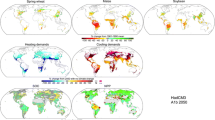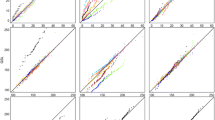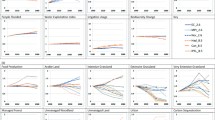Abstract
This special issue of Climatic Change describes an effort to improve methodology for integrated assessment of impacts and consequences of climatic change. Highlights of the seven foregoing Parts (papers) that constitute this special issue are summarized here. The methodology developed involves construction of scenarios of climate change that are used to drive individual sectoral models for simulating impacts on crop production, irrigation demand, water supply and change in productivity and geography of unmanaged ecosystems. Economic impacts of the changes predicted by integrating the results of the several sectoral simulation models are calculated through an agricultural land-use model. While these analyses were conducted for the conterminous United States alone, their global implications are also considered in this summary as is the need for further improvements in integrated assessment methodology.
Similar content being viewed by others
References
J.Alcamo (ed.): 1994, IMAGE 2.0: Integrated Modeling of Global Climate Change, Kluwer Academic Publishers, Dordrecht, Boston, U.K.
Brown, R. A., Rosenberg, N. J., Hays, C. J., Easterling, W. E., and Mearns, L. O.: 2000, ‘Potential production and environmental effects of switchgrass and traditional crops under current and greenhouse-altered climate in the Central United States: A simulation study’, Agric. Ecosystems Environ. 78, 31–47.
Easterling, W. E., Rosenberg, N. J., Lemon, K. M., and McKenney, M. S.: 1992, ‘Simulation of crop responses to climate change: Effects with present technology and currently available adjustments (The ‘smart farmer’ scenario)’, Agric. Forest Meteorol. 59, 53–73.
Hulme, M., Jiang, T., and Wigley, T.: 1995, SCENGEN: A Climate Change SCENario GENerator: Software User Manual, Version 1.0, Climate Change Research Unit, School of Environmental Sciences, University of East Anglia, Norwich, U. K., 38 pp.
Izaurralde, R. C., Rosenberg, N. J., Brown, R. A., and Thomson, A. M.: 2003, ‘Integrated assessment of Hadley Centre climate change projections on water resources and agricultural productivity in the conterminous United States. II. Regional agricultural productivity in 2030 and 2095’, Agricultural Forestry and Meteorology 117, 97–122.
Morita, T., Matsuoka, Y., et al.: 1993, ‘AIM – Asian Pacific integrated model for evaluating policy options to reduce GHG emissions and global warming impacts’, in Global Warming Issue in Asia, Asian Institute of Technology, pp. 254–273.
Nakicenovic, N. and Swart, R. (eds.): 2000, Special Report on Emissions Scenarios, Cambridge University Press, Cambridge, U.K., 612 pp.
Reilly, J., Tubiello, F., McCarl, B., Abler, D., Darwin, R., Fuglie, K., Hollinger, S., Izaurralde, R.C., Jagtap, S., Jones, J., Meams, L., Ojima, D., Paul, E., Paustian, K., Riha, S., Rosenberg, N. J., and Rosenzweig, C.: 2003, ‘U.S. Agriculture and Climate Change: New Results’, Climatic Change 57, 43–69.
Riahi, K. and Roehrl, R. A.: 2000, ‘Technology dynamics and greenhouse gas emissions mitigation: A cost assessment’, Technol. Forecasting Soc. Change 63, 175–205.
Rosenberg, N. J. and Crosson, P. R.: 1991, ‘The MINK project: A new methodology for identifying regional influences of, and responses to, increasing atmospheric CO2 and climate change’, Environ. Conservation 18(4), 313–322.
Rosenberg, N. J., Brown, R. A., Izaurralde, R. C., and Thomson, A. M.: 2003, ‘Integrated assessment of Hadley Centre climate change projections on water resources and agricultural productivity in the conterminous United States. I. Climate change scenarios and impacts on water resources simulated with the HUMUS model’, Agricultural Forestry and Meteorology 117, 73–96.
Rosenberg, N. J. (ed.): 1993, Towards an Integrated Impact Assessment of Climate Change: The MINK Study, Kluwer Academic Publishers, Dordrecht, Boston.
Rosenzweig, C., Iglesias, A., Yang, X. B., Epstein, P. R., and Chivian, E.: 2000, Climate Change and U.S. Agriculture: The Impacts of Warming and Extreme Weather Events on Productivity, Plant Diseases and Pests, Center for Health and the Global Environment, Harvard University, Boston, MA, 46 pp.
U. S.Global Change Research Program: 2000, Climate Change and America: Overview Document, A Report by the National Assessment Synthesis Team, USGCRP, D.C.Washington
Wigley, T. M. L.: 1994, SCENGEN: Model Documentation, University Corporation for Atmospheric Research, Boulder, C.O.
Author information
Authors and Affiliations
Corresponding author
Rights and permissions
About this article
Cite this article
Edmonds, J.A., Rosenberg, N.J. Climate Change Impacts for the Conterminous USA: An Integrated Assessment Summary. Climatic Change 69, 151–162 (2005). https://doi.org/10.1007/s10584-005-3613-8
Received:
Revised:
Issue Date:
DOI: https://doi.org/10.1007/s10584-005-3613-8




